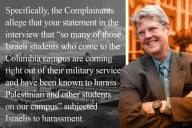You have /5 articles left.
Sign up for a free account or log in.
More than seven months after Johns Hopkins University students and administrators clashed over a proposal to create a campus police force, a faculty committee has released an in-depth investigation of the missteps and miscommunication by both sides that resulted in a volatile situation.
University leaders' inconsistent enforcement of the institution’s free expression policy and student protesters’ mistrust of administrators ultimately led to the May 8 confrontation between 80 Baltimore police officers and students and the arrest of four students in the “largest police action deployed against students in Johns Hopkins history,” according to the report released to the Homewood Faculty Assembly Dec. 16.
Students began occupying Garland Hall, which houses Hopkins’s administrative offices, last April to oppose a Maryland law that allows the university to form its own police force, the Fact Finding Committee’s report said. The students were also protesting against Hopkins's contracts with the U.S. Immigration and Customs Enforcement, the report said. A coalition of 15 student organizations and community members unaffiliated with the university also took part in the sit-in, which lasted 35 days.
The committee interviewed 13 students who were involved in the protest. The committee also received written responses to questions from Provost Sunil Kumar about the sit-in, which escalated into what Kumar described as “no longer a peaceful protest” when students barricaded the building’s doors and covered surveillance cameras and windows. Meetings with administrators to negotiate the end of the sit-in were contingent on the protesters leaving the building, but university officials relaxed conduct guidelines on the first day of the sit-in and allowed the protesters to remain overnight, the report said.
“In this way, it made the students fully responsible for the absence of discussion,” the report said. “The administration authorized the occupation of Garland Hall then cited the occupation as its justification for refusing to meet with the students.”
The university has tried to minimize the sit-in and dismiss those who participated as a minority of students, but the committee’s report proves otherwise, said Dre Fraser, a doctoral student who participated in the sit-in.
As many as 300 to 500 different students demonstrated in Garland Hall over the course of the occupation, and about 90 percent of all protesters were students, according to the report. The faculty committee also determined the demonstration was representative of student sentiment among a broad swath of the student body, a finding based on a Student Government Association poll of 35 percent of undergraduates in which three-fourths opposed creation of a campus police department.
“We have this culture of fear that’s operating,” said Fraser, who is studying environmental health and engineering. “They try to say that there’s a silent majority that supports the police who aren’t speaking up because there are so many people outspoken against it. The university tried to call us a small special interest … It’s a lot of minimizing and rewriting this twisted narrative of how they value democracy.”
The university is in the process of reviewing the 46-page report and has posted information about the Garland sit-in on its website, a statement from Hopkins said.
"The university has sought to be as transparent as possible about the events of last April and May, and we have posted extensive materials about the protest and the university’s response to it on the website of the provost, including responses to the faculty assembly’s questions," the statement said.
The investigation found some discrepancies between the interpretations of events by student protesters and administrators. For instance, Hopkins president Ronald Daniels considered a conversation he had with two representatives from the sit-in on the first day it started “a meeting,” said Jennifer Culbert, a political science professor and chair of the faculty committee. Student protesters, on the other hand, described the interaction with Daniels as a random and short encounter on his way out of Garland Hall, Culbert said.
Students also claimed they were given less than 24 hours' notice for a formal meeting with administrators on May 6 that initially did not promise amnesty for protesters under the student conduct code. Administrators said the meeting offer was sent days in advance "with no strings attached," according to the report. The students ultimately declined to meet with administrators.
“What we found was a lot of suspicion that created a sense of anxiety and disillusionment and fear,” Culbert said. “That’s what we were witnessing when we were called to look at what was happening. The accounts weren’t so profoundly different."
Students involved in the sit-in have taken the faculty committee’s criticism of their decision not to meet with administrators to heart, said Mariam Banahi, a doctoral student who participated in the sit-in and was interviewed for the faculty report.
“I hope the university reads this with great care and reflection,” Banahi said. “There’s a lot in the report that would help make the university a better place for Johns Hopkins students and the community … What’s interesting is the administration refused to be interviewed. It speaks to a lot of what we saw during the sit in -- no one was comfortable enough to engage with faculty, students or other communities on campus.”
While the faculty committee did receive “careful” written responses from Provost Kumar, committee members were frustrated that inquires to lower-level administrators with direct knowledge about official decisions regarding the sit-in were delayed and ultimately went unanswered, Culbert said. These administrators were suspicious of the committee and feared losing their jobs even though the faculty assembly intended for the report to be an impartial analysis of what took place and what led to traumatic police intervention, Culbert said.
“It wasn’t as straightforward, and for reasons we still don’t know, it couldn’t be,” Culbert said of the responses received from administrators. “Consequently, there are certain questions that remain unanswered … The community has been very profoundly affected by this. It would’ve been better to have a more personal conversation.”
Karen Lancaster, Hopkin's assistant vice president of external relations, disputed the accounts of suspicion and fear among lower-level administrators and said such characterizations lacked "any factual basis."
Culbert said university administrators had also promised “amnesty” for students who willingly left Garland Hall when Baltimore police confronted the protesters, but many students who participated in the sit-in received letters that warned of sanctions if more conduct violations are committed. The administration seems to be defining amnesty in its own way and has not made clear whether it will continue to issue the letters, which creates even more distrust and uncertainty among students, she said.
Banahi, the doctoral student, said she was required by the university to attend an administrative hearing for her participation in the sit-in and warned that any noncompliance with the university’s disciplinary requirements could jeopardize her receiving her doctoral degree in anthropology.
“Not only was there a small group targeted for them to make an example of … we were told what to do and what our punishments would be to scare people without causing a bigger ruckus,” Banahi said.
Some student protesters who did not voluntarily leave Garland Hall received conduct letters because they were ineligible for amnesty, Kumar said in his response to the committee.
“Student protesters who received either amnesty or conduct letters were identified based on staff knowledge and observations, security observations and reports, and/or students’ own public social media posts about the protest and occupation,” the report said. “Amnesty letters are letters memorializing offers of amnesty, and the terms of that amnesty; they are not formal warning letters.”
Johns Hopkins has a long way to go before trust is restored, especially as it moves forward with creating a campus police force, Culbert said. The university is in the process of forming an Accountability Board of students, staff and outside community members to consult with the police department, a decision Culbert believes was a result of student and faculty opposition. Lancaster said creation of the board was already in the works before the sit-in and was originally proposed by university administrators in December 2018 and was included in the state legislation that allowed Hopkins to create the police department.
“It’s not clear what the long-term effects of all this will be,” Culbert said. “We can’t change how this is viewed in the future, but I think we can bring this to light … there’s a lot of work to be done still to make up the ground that [the administration] lost.”








